The variegated umbrella tree plant is a beautiful plant with delicate variegated leaves in an umbrella shaped pattern.
This is an easy houseplant to care for and makes a beautiful statement piece in your home or office. I have my variegated umbrella plant in my kitchen and I always get asked about it. It is a stunning houseplant.
These plants grow native in Taiwan and they love bright indirect light (especially if you want to encourage variegation in the leaves). This plant will want lots of humidity that helps mimic its natural growing environment.
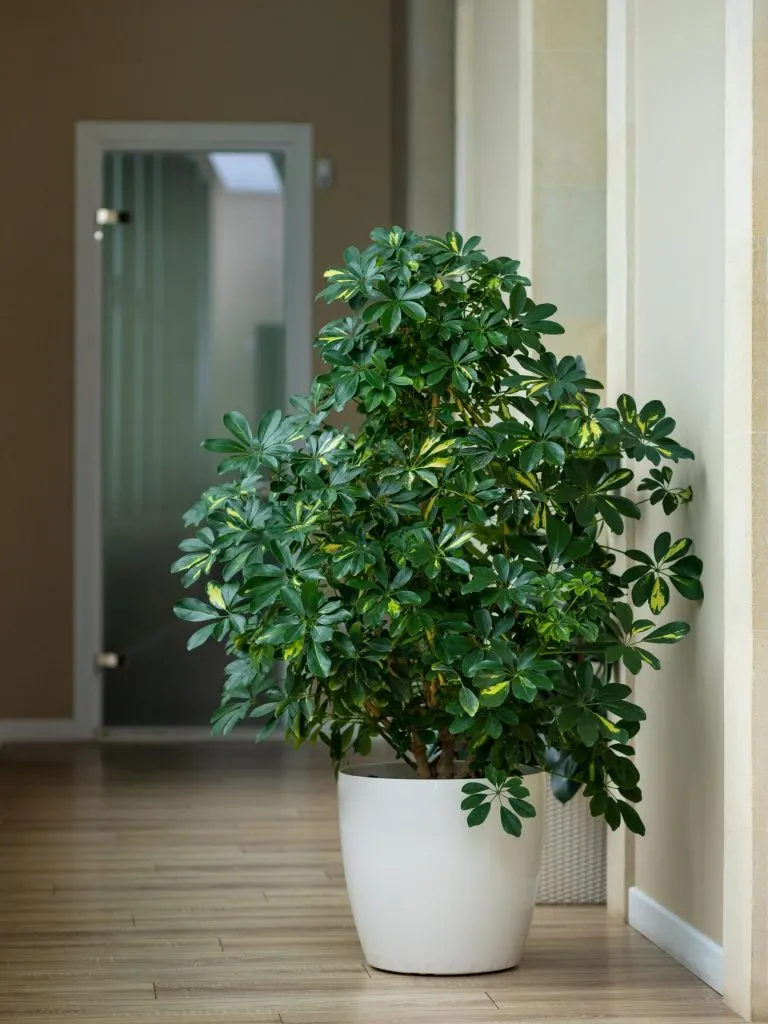
This plant can drop leaves when it is stressed or not being cared for properly. If your umbrella tree is dropping leaves here are a few things to look at.
Umbrella Tree Plant Dropping Leaves
- Watering (over or under watering)
- Lighting
- Pests
- Improper substrate
Watering on a proper schedule is important for all houseplants. The variegated umbrella tree plant can get root rot if water is left sitting around the roots. It is better to underwater this plant than it is to overwater it. I water mine once every two weeks. Give it a really good soaking when you water it.
Lighting is important for two reasons with this plant. The first reason is the beautiful variegation. If you put this plant in a low light area, it will give you green leaves with very little variegation. The brighter the light the better the variegation.
The other reason lighting is important is the growth pattern of the plant. If you place this plant in a low light spot, it can grow very leggy and spindly. This can also cause the plant to drop leaves.
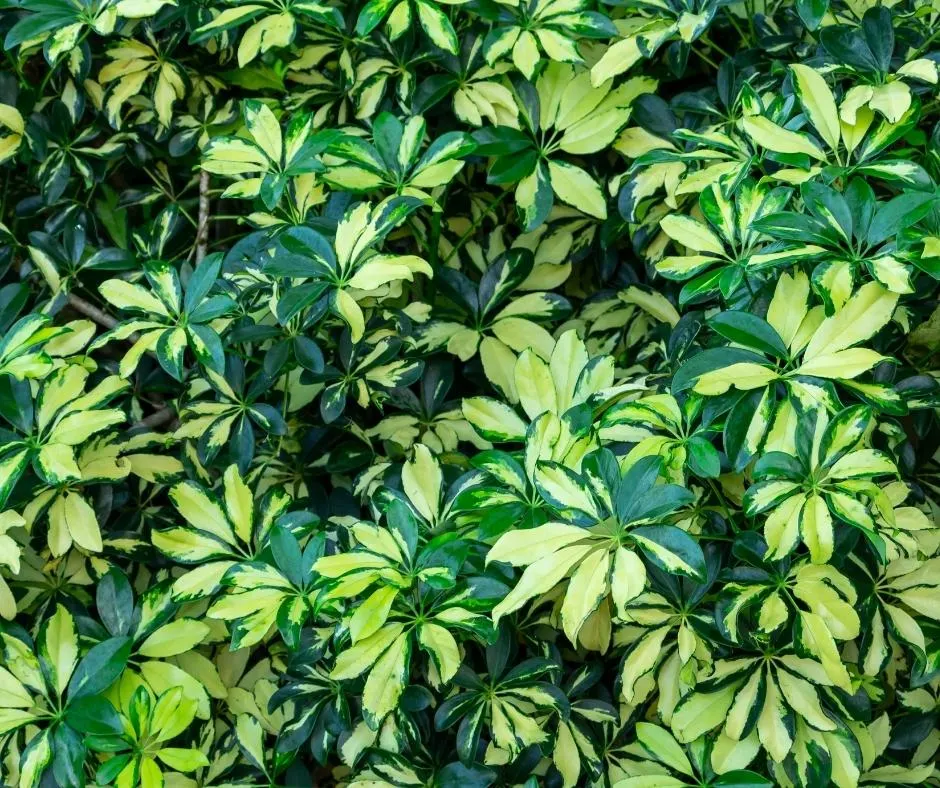
Pests will also cause leaf drop with this plant. If you are having problems with leaves dropping and signs of damage on them, check for pests. I like to give this plant a shower when I water it. I use my kitchen spray nozzle to spray all the dust off the leaves when watering.
Finally, you can look at substrate and make sure you have your plant in the proper potting medium. My favorite mix for this plant is a light and quick draining soil. You do not want thick and heavy soil compacting around the roots of this plant. I use potting mix, perlite, and orchid bark.
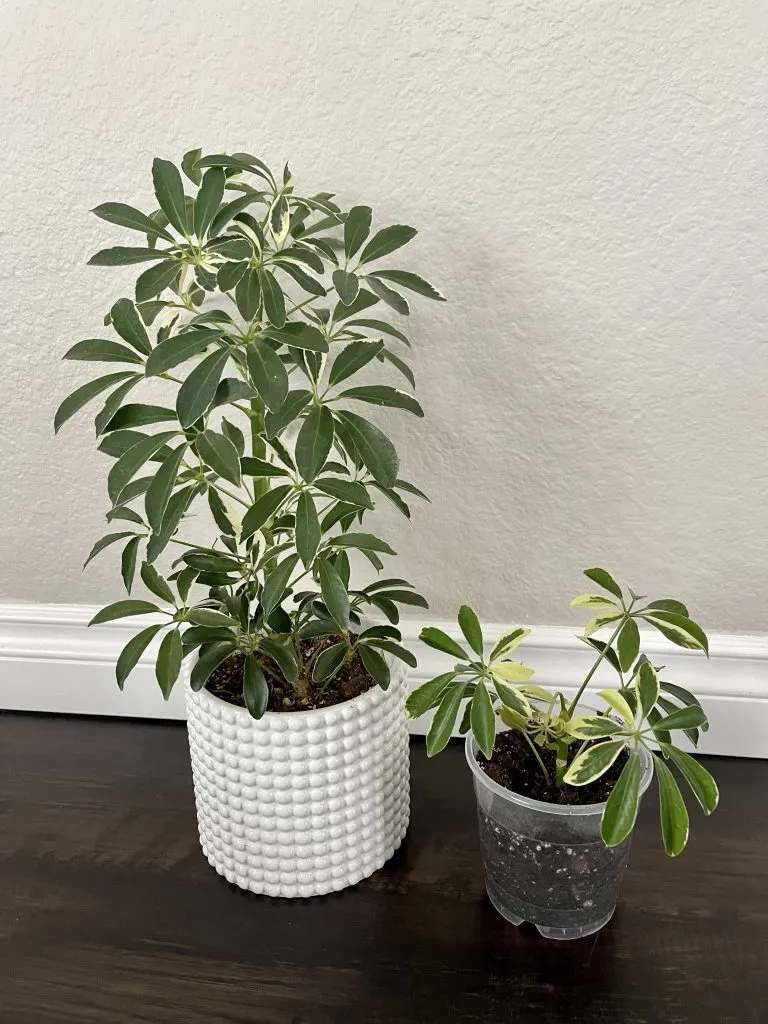
More Beautiful Houseplants:
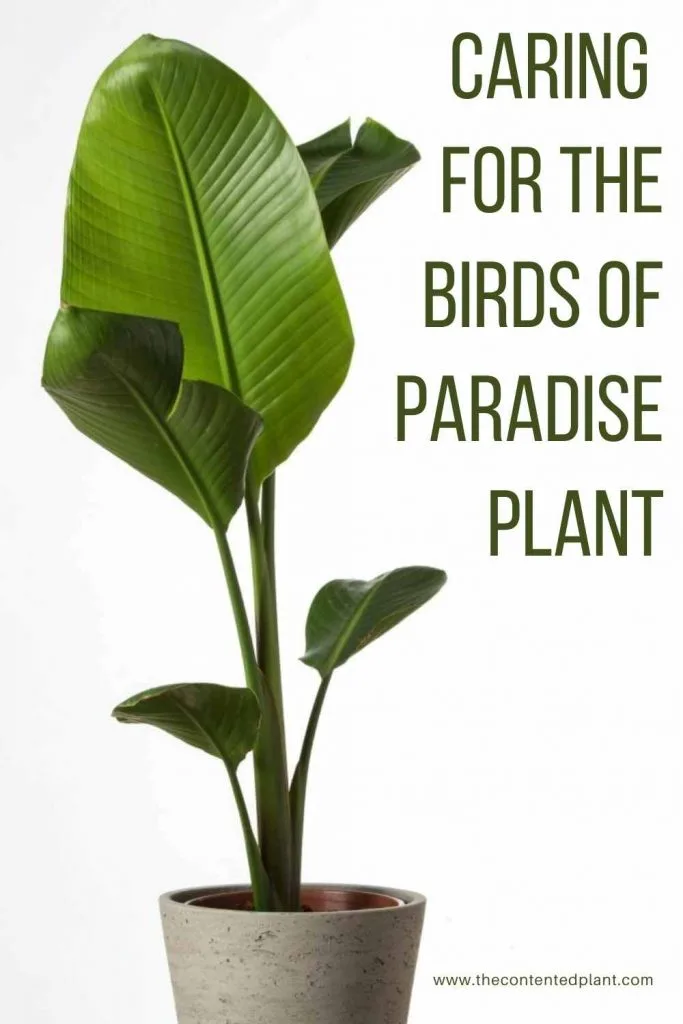
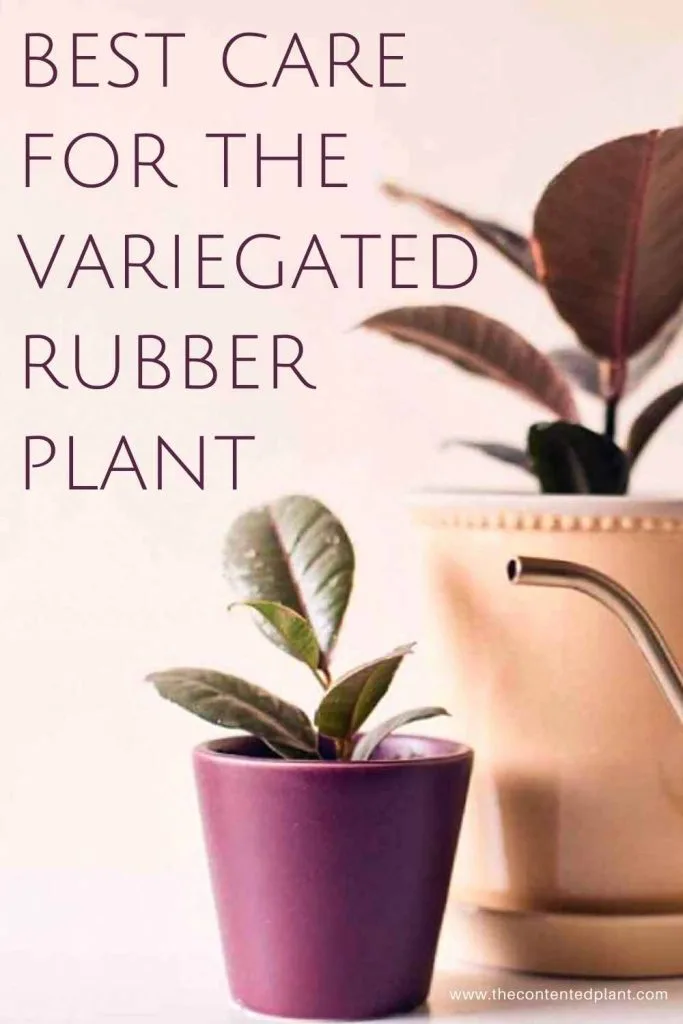
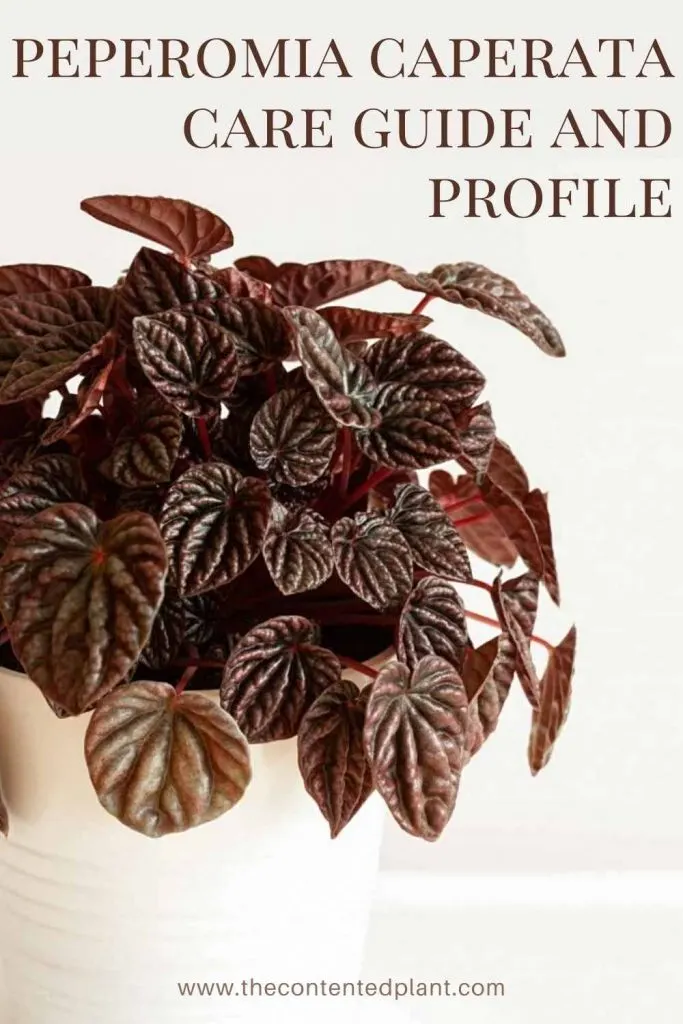
You can find this beautiful plant at most local nurseries or greenhouses. This isn’t a rare or particularly hard to find plant. If you are having trouble locating it locally, a great option is purchasing it online. I buy my online plants from small hobby plant growers on Etsy.
Click here to buy the Variegated Umbrella Tree Plant on Etsy
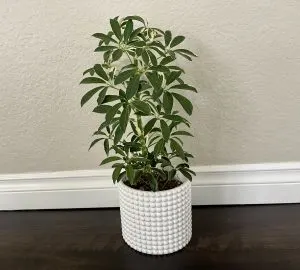
Although this plant is a very easy plant to grow, a few tips and tricks can ensure that you have the most beautiful healthy Variegated Umbrella Plant. We have compiled a list of all the top care tips we have for this plant. This care guide is printable if you want to save it for later.
Variegated Umbrella Plant Care Guide
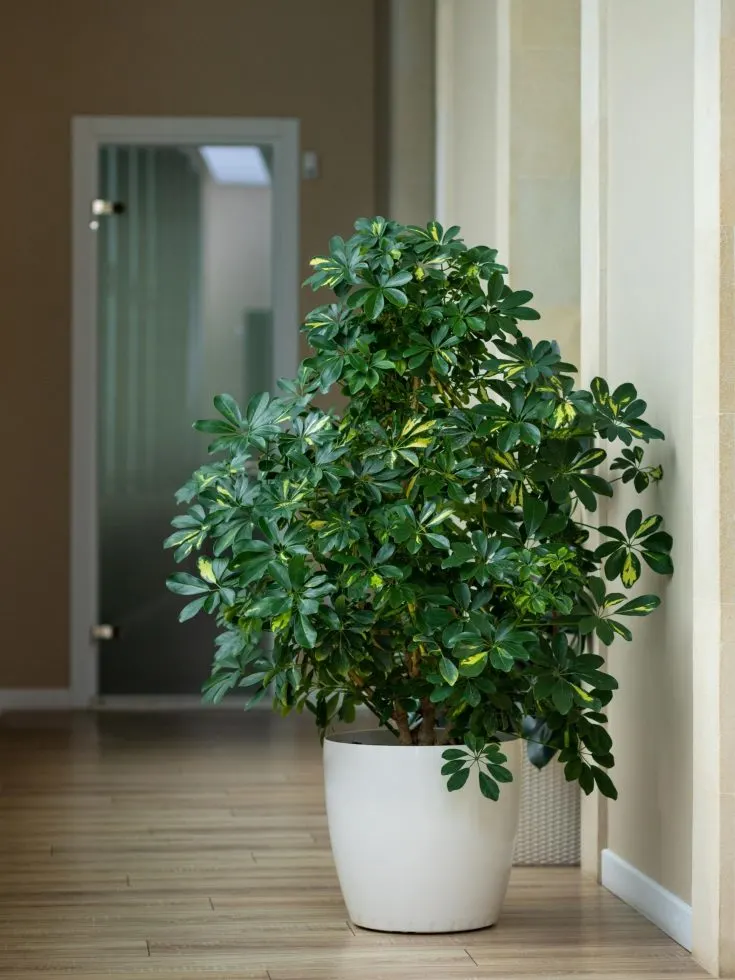
The Variegated Umbrella tree plant is a beautiful plant with variegated leaves that grow in a little umbrella shaped pattern.
This lovely bush is a perfect beginner houseplant. This plant will grow well outdoors in climate zones 10 and warmer.
Materials
- Perlite
- General potting soil
- Orchid Bark
- mask
- Fertilizer
Instructions
Soil Preference:
- The umbrella tree enjoys a light well draining soil.
- A mix of potting soil and perlite will keep the roots happiest.
- Our mix for this plant is 60 % potting mix to 20% perlite and 20% orchid bark.
- A heavy soil potting mix is not recommended for these plants.
Pot Size and Type:
- The variegated umbrella tree will grow to the size of its pot. They can tolerate being root bound.
- If you want to encourage faster growth choose a pot about 2 inches wider in diameter than the current pot.
- Any well drained pot can be used. It MUST have drainage.
- Repot every second year or when roots come out the drainage holes on the pot bottom To the next pot size up.
- Don't jump to a huge pot from a small one unless you wish to encourage faster growth. Just go to the next size up pot.
Lighting:
- This plant enjoys indirect bright or dappled direct light.
- It will tolerate lower indirect light it if has some brighter moments in the day. If the light is too low the leaves will begin to fall. The plant will get leggy and thin as it stretches to the light. Move to brighter light.
- Variegated umbrella trees like the cultivar "Gold Capella" needs stronger light to bring out the variegation in the leaves to best advantage.
- Shield this bush from strong direct light in summer south and west sunny windows. The leaves may burn. Look for dry brown spots on the leaves. If you see them move the plant to lower light.
- Tip: Window sheers or blinds can offset some brief periods of high direct light.
Watering:
- Water your umbrella tree when the soil is dry down an inch or more. Tropical plants in general do not like to be overly wet. Try a watering schedule of every other week.
- Watering is best done on a regular schedule so the plant is not over or under watered. Both can cause stress on the umbrella tree.
- This tropical plant enjoys humidity. In dry climates this bush will thrive with a humidifier nearby. or set it in your kitchen or bathroom. For a really dry climate frequent misting will help.
- In dormant winter months reduce watering to when the soil is dry down halfway .
- Never let this plant get wet feet. If the soil is compacted the bottom of the soil can remain wet which encourages root rot and Fungus Gnats. If you see yellow leaves you are probably overwatering.
How to Fertilize:
- Apply a good quality fertilizer (linked in materials) monthly through Spring and summer.
- Decrease feedings by late Fall and allow your umbrella tree to rest through the winter months.
- Look for brown spots on the leaves of your plants. This may indicate an over concentration of salts in the roots from over feeding. It can burn the leaves.
- The remedy is to set the plant under a faucet of water and let the water run through for 10 minutes or so. Allow the pot to Completely drain. Discontinue fertilizer until the plant recovers.
Temperature:
- Optimal temperatures for the umbrella trees are 55 to 75 degrees F.
- However, Umbrella trees are durable and capable of withstanding cooler temperature, temperature changes and drafts. This makes them good candidates for patios and drafty hallways or entry areas.
- They can be grown outside year round in climate zones 10 to 12.
- In cooler climates they will grow well in summer outside in the proper conditions but must come indoors when temperatures drop.
- They cannot tolerate freezing temperatures or long term exposure to direct strong dry heat like heat vents or harsh dry winds. .
Pruning and Training:
- Pruning will give you a fuller plant with more even growth.
- Umbrella trees can be grown as a small tree indoors with a single large stem forming the trunk. Or the stem can be braided like a Money tree.
- Sharp Hand pruners are preferred for pruning. They will give a clean cut that will heal quickly.
- Prune in between the leaf nodes. Shaping umbrella tree is recommended. They will get leggy if left to themselves.
Table Top Plants or Window Sill Plants or bonsia:
- It’s easy to prune and shape these plants to whatever length and fullness you desire.
- As a table top plant cut the longer stems back evenly all around the pot.
- And keep the pot size small to keep dwarf umbrella trees table top size.
- Umbrella trees can be pruned in the bonsai method.
Leaf Care:
- For the best care leaves enjoy occasional washing.
- This helps keep the stomata (leaf pores) open for plant respiration.
- Healthy leaves with a good clean surface are most able to resist pests.
- Dusty leaves will starve the plants of water exchange through humidity.
- Hand Wash with water. or use milk to wash clean leaves to create a shiny surface.
- You can also use a hose or shower to clean off a larger umbrella tree.
Pests:
We have posts on all the pests listed below. Click the links to learn more about them and how to get rid of various pests on your plants.
- Umbrella trees are not fussy and resist pests quite well when in good health. However all plants get attacked by pests.
- Stress by longterm poor watering practices, poor light, extreme temperatures and soil conditions are contributors to pests.
- Washing the umbrella plant leaves occasionally will help keep pests from establishing themselves on the plant.
- Spider mites are the biggest problem for umbrella plants. Watch for the webs. Treat immediately and continue for two weeks or more to remove the next generation of spider mites after the adults die. Eggs attach to the leaves and cannot be washed off.
- mealy bugs, scale, thrips and whitefly are also common houseplant pests you will see in a stressed schefflera.
- Read our post on How to get rid of aphids and other pests with our homemade pesticide soap recipe or neems oil.
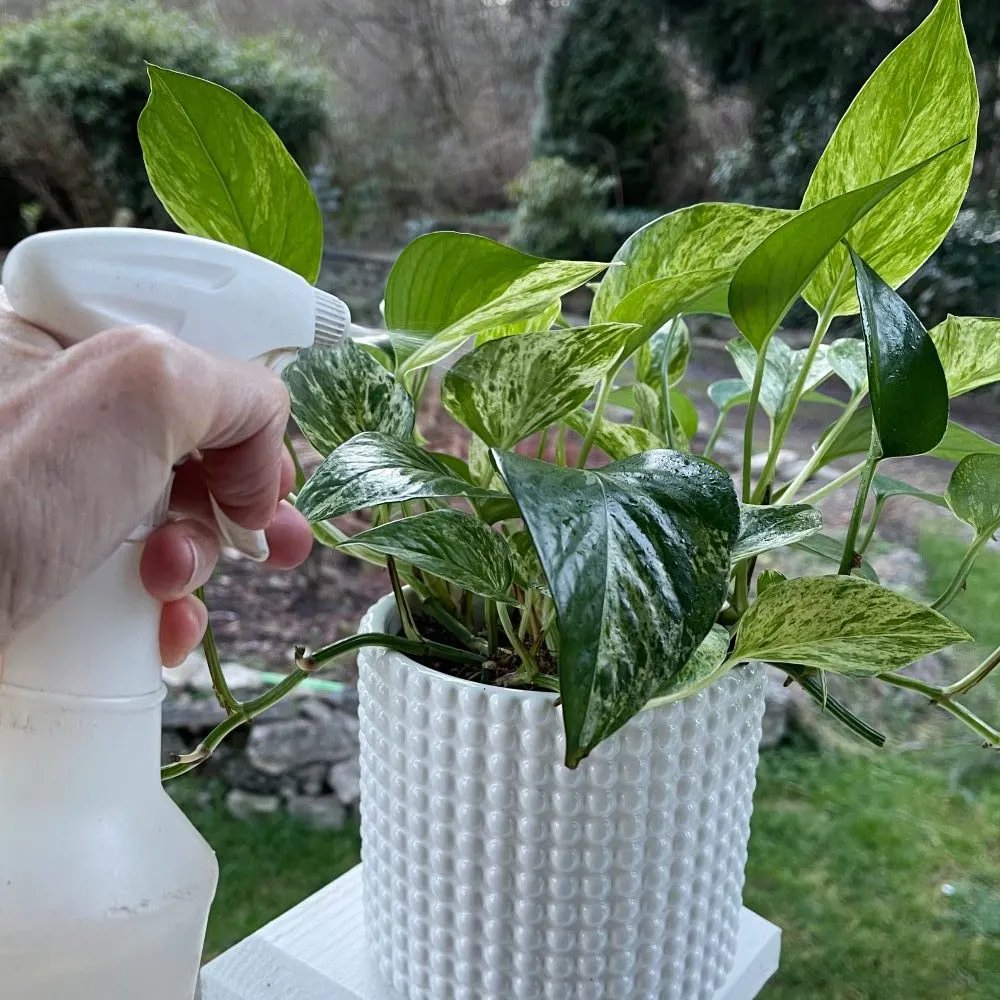
- To minimize the possibility of pests be sure to check all nursery plants before bringing them home.
- Quarantine all new plants until you are sure no pests live in them.
How to Propagate Umbrella Trees:
- Propagation is best done through stem cuttings.
- You need a 3 to 6 inch leaf stem with a node and healthy leaf top.
- Cut the stem in between two nodes. Strip off the bottom leaves.
- Place the stem into a jar with water. Use tap water that has settled 24 hours in the jar to dissipate chemicals harmful to the plant.
- Set the jar in a well lit area.
- After several weeks roots will grow. Allow the roots to get an inch or more in length.
- Plant gently and firmly into pot with proper soil mix.
- Make sure to keep the soil moist until the roots begin to set into the soil.
You can also plant the stem cutting directly into moist soil. Rooting hormone may help get the process started.
You can also use air layering or seed to propagate umbrella plants. For most houseplant owners stem cuttings are the easiest method.
Toxic Plant:
This plant contains Calcium oxalate crystals are toxic to humans and pets.
- This is a medium toxin and non lethal.
- Symptoms: Difficulty swallowing, irritation and burning in the mouth and throat, drooling, vomiting
- Poison Part: Leaves
Thank you so much for reading our post about the variegated umbrella plant. We hope this cleared up any basic care questions you may have about this plant. Let us know if you have more questions down below and we will do our best to answer them for you!
Follow Us:
Find us on YouTube, Instagram , Pinterest and TikTok! We love to Plant chat. We also comment, like and occasionally share your content to our daily stories. We’d love to see your plants. Share your joy in your houseplants. Happy Planting!
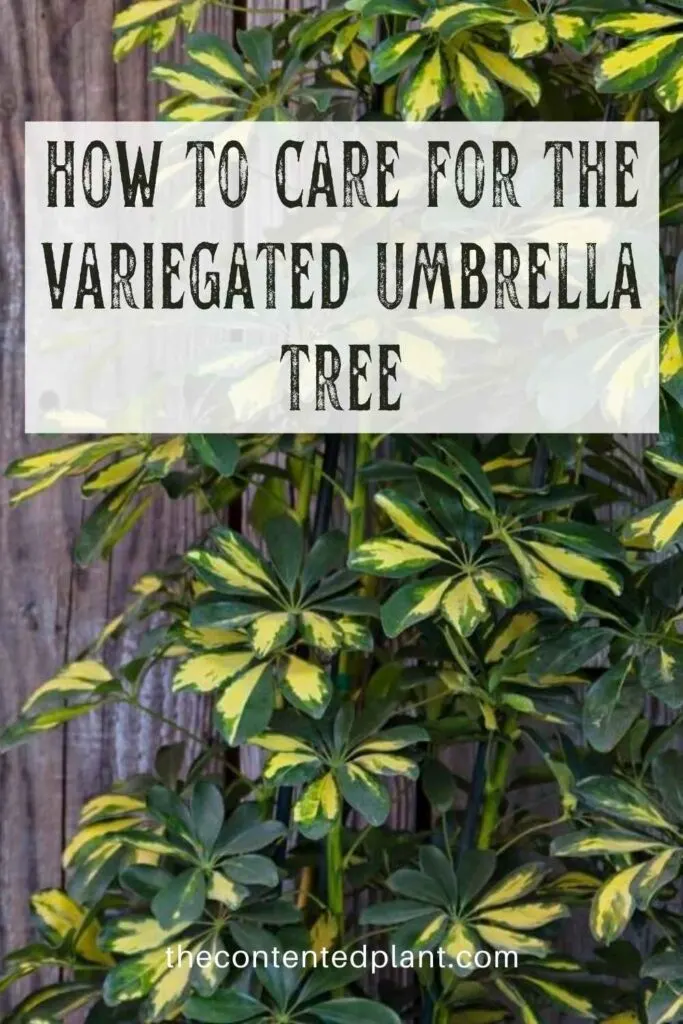

Árbol Paraguas Variegata - Gardenun
Tuesday 1st of November 2022
[…] https://thecontentedplant.com/variegated-umbrella-tree-plant-care-guide/ […]